Paros Guide
Paros Ferry Port
Lying in the Aegean Sea, Paros is a Greek island forming part of the Cyclades island group. There are many ferry routes departing the port, heading to other coastal towns belonging to Greece, and are supplied by four ferry companies.
What is there to do in Paros?
Primarily known as a ferry hub, Paros has remained under the radar among the hype of other popular Greek holiday destinations. Though its relative anonymity is quickly coming to an end; warm and welcoming rural villages surround the alluring capital city, offering visitors the chance to indulge in Greek cuisine in beautiful surroundings. The harbour still attracts the biggest crowds, especially in the spring time when the island is less busy, the weather is pleasant and the water become slightly warmer.
The shoreline is constructed of unique rock formations and golden sands; Kolymbithres Beach is perhaps the most aesthetically interesting area across the coast, which provides unmatched views of the endless azure blue seas engulfing the smaller neighbouring islands. Away from the waters, myriad of historical and cultural sites are dotted about the island, providing a fascinating insight into the history of Paros. Panayia Ekatondapiliani Cathedral is typically at the top of the itinerary for most tourists, and for an extended look at the archaic architecture, head to Parikia Town which is host to many cultural landmarks.
How do visitors get around Paros?
Car and motorbike rental companies are fairly cheap throughout the year, though the prices increase in the summer months. In terms of public transport, a bus service operates frequently throughout the towns, and are generally quite affordable.
Patmos Guide
Patmos Ferry Port
Patmos is one of the northernmost islands belonging to the Dodecanese island group, and is one of the many islands laying to the east of the Greek mainland. Many ferry routes depart the port, heading to many other Greek islands and are supplied by three ferry companies.
What is there to do in Patmos?
Most famous for being the setting for the Book of Revelation, Patmos still maintains its spirituality among the modernisation inevitably caused by the growing tourism industry. The harbour attracts the main block of tourists, especially in the warmer months where the restaurants offer picturesque views whilst serving delicious sea food fresh from the waters. To form a taste of the traditional values associated with Patmos, head to the surrounding villages that provide an insight into the island’s history whilst basking in the warm, welcoming atmosphere.
After exploring the history of Patmos, it is worthwhile heading to the coastline to enjoy the golden sands and azure blue waters that encompass the island. Psili Ammos Beach is the most popular with visitors, offering a particularly mountainous landscape that is perfect for embarking on a leisurely stroll under the afternoon sun. The entire island is littered in challenging walking trails and steep hills, so it’s the perfect place to escape the stress of the modern world.
How do visitors get around Patmos?
Patmos is fairly small so it is possible to cover much of the island by foot. Alternatively, there are taxis readily available.



